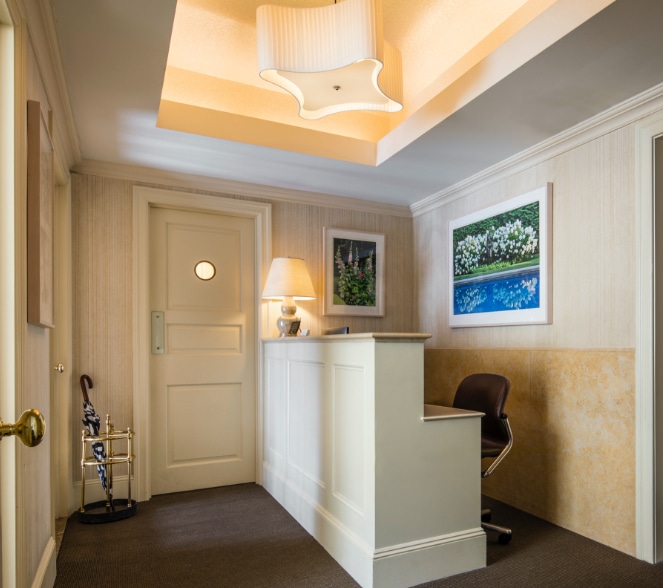The Man of a Thousand Face-Lifts

David Hidalgo in the operating suite of his New York office, holding a diptych of two drawings made of his late mother Lotte.
When he's not wielding a scalpel to mold skin, tissue and fat, plastic surgeon David Hidalgo expresses his creative instincts with another set of tools: graphite pencil and paperboard.
Working from old and new photographs, Dr. Hidalgo makes meticulous drawings of the alterations that time makes on a face—his subjects have included his parents, his wife, himself, even his dog. Many of them hang, along with colorful still-life oil paintings he did before deciding it wasn't the best medium for him, in the Park Avenue office where he performs a steady stream of face lifts, breast augmentations and reductions, and other procedures.
One of the country's best-known plastic surgeons, Dr. Hidalgo, 60, is a regular on annual best-doctor lists in his specialty. But art was his first love. He started sketching at the age of six. He took courses in drawing, sculpture and painting as an undergraduate with a double major in fine arts and biology at Georgetown. There, at 19, he met his wife, real estate executive Mary Ann Tighe, when she was a 23-year-old teaching an art history course. But after choosing what he considered the more practical and remunerative career path by attending Georgetown's medical school, he found that the skills and instincts of art and medicine were not so far apart. His studies of how people look as they age have helped him, as a surgeon, to reverse that process.
"Art and surgery are very complementary," he said. "Art teaches you to become familiar with the subtleties of shape and shadow, which make a breast look like it does, and carry over into aesthetic surgery."
To be sure, surgeons don't start with a blank canvas, and they must follow strict rules of procedure. But Dr. Hidalgo's attention to photorealism helps when he has to determine just how much skin to remove from a droopy eyelid so that the excess is gone, the patient looks refreshed, and the eye can still blink normally, or when he is performing a face-lift, cutting through skin and tightening its layers. "You have to focus on minute artistic details, appreciating thickness and form and hiding scars as much as possible."

PICTURE THIS | David Hidalgo sketches show rhinoplasty patients their profiles after surgery.
Dr. Hidalgo, who is affiliated with New York-Presbyterian Hospital and a clinical professor of surgery at associated Weill Cornell Medical College, trained as a general surgeon before specializing in plastic surgery, learning microsurgery in its early days, with the intricacies of reattaching severed limbs and blood vessels. For nearly a decade, he was chief of plastic surgery at Memorial Sloan Kettering Cancer Center, making new breasts for mastectomy patients and reconstructing faces ravaged by cancer treatment. He became known for a major advance in the field—replacing jawbones that had been removed with new ones created from grafts from the fibula, a bone in the lower leg.
But in 2000, Dr. Hidalgo decided to shift his focus entirely to cosmetic surgery. It was more lucrative, of course, but he was also beginning to be worn down by spending up to 20 hours at the operating table, the rigors of harvesting bone and the unpredictability of being called in to put patients back together after cancer surgeons had finished their work.
When he first meets patients, Dr. Hidalgo said that he analyzes their faces as they speak, breaking them "down to subunits—eyelids, cheeks, lips, chin." He urges patients to determine their own priorities, such as fixing saggy skin or droopy eyelids. Though he doesn't dictate to patients what they should do, he may make suggestions if they ask for them. For example, a patient with a large nose might not recognize that a more prominent nose can make an aging face look worse, and a nose job could help with the younger look he or she wants. "Patients don't always see the whole gestalt of their own face," he said.
Understanding the gestalt is a skill honed by his graphite drawings, displayed as diptychs, which use photorealism to convey "the theme of time and the transition that has occurred between the younger image on the left and the older on the right," he said. Doing them helps him to relax more than anything else, "but it's also about training the eye." he said. "Drawing shapes, shadows and lines enhances my ability to see surgical shapes, forms and lines."
One diptych of his wife, a striking brunette, shows her as a young mother holding their little boy and as a mature yet still beautiful woman in the same pose with that boy's son—their grandson. Ms. Tighe, who chose her husband to perform facial surgery on her a few years ago when she decided she needed a fresher look, said, "No one reverses time, but the trick is to make people look not like their younger selves but like their best self at that moment in time."
Often Dr. Hidalgo has to explain limitations: There is only so much that can be done to rejuvenate sun-damaged skin with no elasticity, and someone who has big neck glands will still have them even if skin on the neck is tightened. When preparing a patient for surgery, he uses black ink to mark in lines and dots where he will make his cuts, whether for the eyelids, face or abdomen.
In a common face-lift procedure, he tightens the layer of tissue under the skin to remove jowls, restore cheek contour and soften nasal folds. The technique minimizes the amount of skin that is removed, avoiding a too-tightly-pulled look. He may need to spend up to 6½ hours for so-called "pan-facial rejuvenation," which could include a face-lift, eyelid surgery, chin implant and resurfacing of the mouth area with a chemical peel.
Bad plastic surgery stands out, he said, when surgeons go too far to bend patients into a textbook, cookie-cutter notion of how something should look, using every tool and procedure at their disposal. "It isn't the goal to eliminate what's asymmetrical in nature, but to enhance what is there in spite of asymmetry," he said. "Sometimes you have to be more respectful of the nuances in nature that are responsible for asymmetry."
Though a surgeon's work on a patient can't endure like a painting or drawing, Dr. Hidalgo thinks that surgeons can leave a legacy of creativity in another way. "It isn't just about individual cases but about advancing the field" he said. "If you can train 100 surgeons in how to make the field better, you can have far more influence than by operating on 1,000 more patients."
This fall, Dr. Hidalgo returns to Georgetown—but not to teach medicine. The university is hosting a show of his art work.




